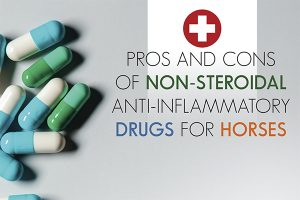Pros And Cons Of Non-Steroidal Anti-inflammatory Drugs For Horses
Click here to read the complete article
290 – March/April, 2024
Humans and horses share some of the same ailments like painful arthritis, swelling and discomfort from injuries, sore muscles, etc. that can benefit from anti-inflammatory medication. Steroids can relieve pain and swelling, but have some adverse side effects, especially if given frequently. Non-steroidal anti-inflammatories (NSAIDs) are more commonly used. Humans often self-treat with Advil, ibuprofen, aspirin, etc. and horse owners frequently use Banamine, Phenylbutazone (Bute) and some of the newer equine NSAID products for their horses.
Dr. Mary Robinson, Assistant Professor of Veterinary Pharmacology, University of Pennsylvania School of Veterinary Medicine, New Bolton Center, is Director of the Penn Vet Equine Pharmacology Laboratory and Acting Director of the Pennsylvania Equine Toxicology and Research Laboratory. She says that NSAIDS are safer and more versatile for use in horses than are steroids or pain-killing drugs like opioids.
A painkiller is a drug that simply targets pain. “There are a couple different classes of drugs that relieve pain. The opioids are probably the one people are most familiar with and morphine is the classic example–a drug that has been used for thousands of years. There are also drugs that we can use as local blocking agents (such as lidocaine, etc.) that block pain transmission from the site of the pain to the brain. An example would be a nerve block when the veterinarian is trying to figure out where the horse is hurting, and going up the leg and blocking nerves in different places,” she says.
Various pain-killing drugs have different mechanisms of action. “The opioids primarily target the opioid receptor in the brain. This diminishes the sensation of pain.” That’s about all they do, however; they don’t diminish swelling and inflammation.
Click here to read the complete article
290 – March/April, 2024











